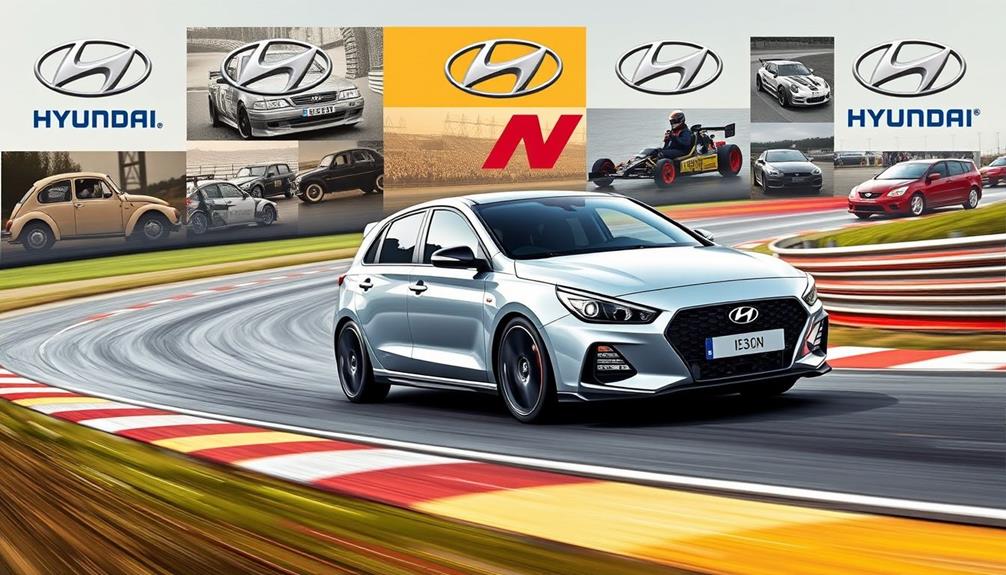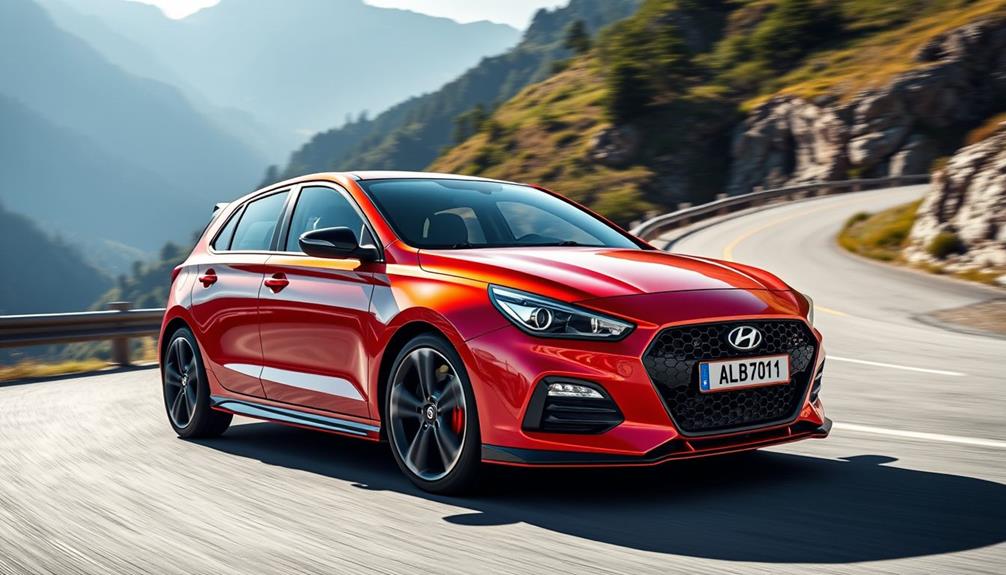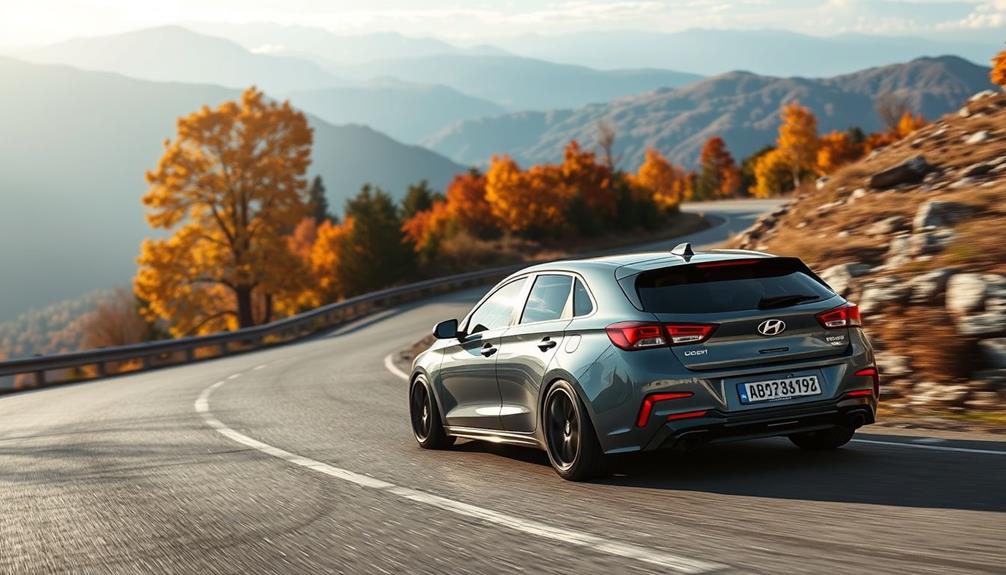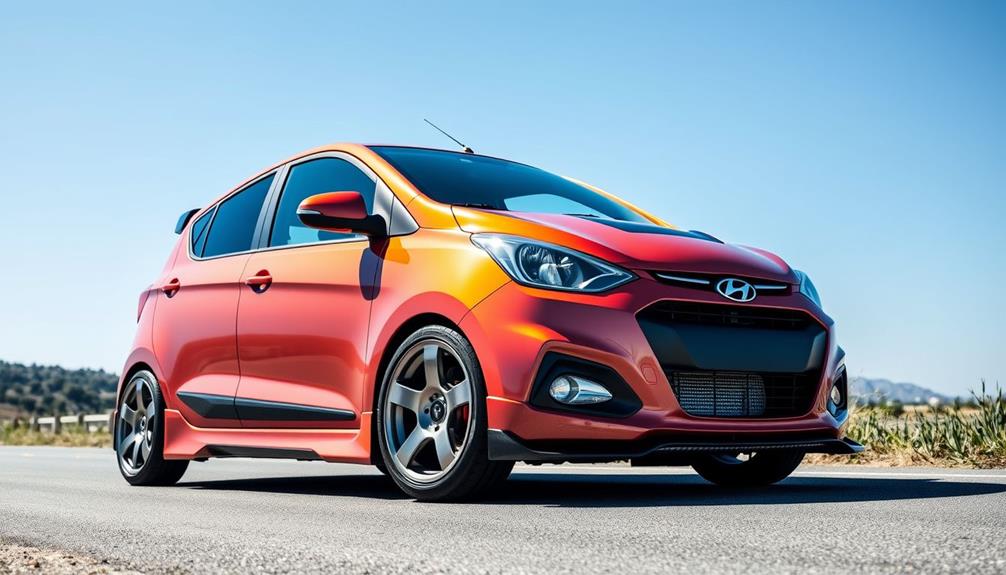Tuning your Hyundai i30 N releases its true power, elevating the standard 271 horsepower to an impressive 304 horsepower and beyond. You'll experience a rush like never before, thanks to enhancements that boost torque figures and optimize handling. The N Grin Control System tailors your driving experience, while upgrades like the CRTD4 tuning box push limits to an exhilarating 450-470 horsepower. With features like the Electronic Limited-Slip Differential, your cornering and traction improve considerably, giving you confidence on the road. There's so much more to explore about maximizing your i30 N's potential and keeping it at peak performance!
Key Takeaways
- Tuning the i30 N can boost its standard output from 271 to 304 horsepower, enhancing performance significantly for enthusiasts.
- Utilizing a CRTD4 tuning box allows for increased torque from 353 Nm to 438 Nm, improving acceleration and responsiveness.
- Regularly monitor engine health and boost levels, as exceeding 29 psi can risk catastrophic failure during high-performance driving.
- The N Grin Control System offers customizable settings for engine response and handling, enhancing the driving experience tailored to your preferences.
- Engaging with the i30 N community provides valuable insights and shared experiences for successful tuning while considering warranty implications.
Overview of Hyundai I30 N
The Hyundai i30 N is more than just a compact hatchback; it's a thrilling blend of performance and design that reflects Hyundai's motorsport roots. With its 2.0-liter turbocharged engine, the i30 N delivers an impressive 276 horsepower, allowing you to go from 0 to 60 mph in just 6 seconds. This power means you'll experience exhilarating acceleration that makes every drive an adventure.
Inside, the i30 N boasts a driver-focused design featuring sporty seats and a fine-tuned suspension, ensuring comfort and support during spirited driving. Whether you're maneuvering tight corners or cruising on the highway, you'll appreciate how responsive and engaging the i30 N feels.
In the competitive hot hatch market, the i30 N stands tall against rivals like the VW Golf GTI and Ford Focus RS. Its aggressive styling, highlighted by a prominent N grille, aerodynamic elements, and striking red accents, makes it a standout on the road.
Plus, with competitive pricing and features, the i30 N offers exceptional value for anyone seeking a high-performance compact hatchback that doesn't compromise on style. So, are you ready to experience the thrill of the Hyundai i30 N?
History of Hyundai N Division

The Hyundai N Division kicked off in 2013, driven by a passion for motorsport and a desire to create high-performance vehicles.
This initiative not only draws from Hyundai's racing heritage but also aims to challenge established brands in the performance market.
You'll see how this commitment to thrilling driving experiences has shaped models like the i30 N and redefined what a hot hatch can be.
Origins of N Division
Often overlooked, the origins of Hyundai's N Division reveal a strategic shift towards high-performance vehicles that stems from the brand's deep motorsport roots. Established in 2013, the N Division was created to develop thrilling, high-performance models inspired by Hyundai's racing spirit.
The "N" in the division's name comes from the Namyang R&D center in South Korea and the legendary Nürburgring racetrack in Germany, emphasizing Hyundai's commitment to performance and engineering excellence.
With the N Division, Hyundai aimed to compete with established performance brands, transforming its image from a mainstream automaker to a contender in the hot hatch segment. The development of the i30 N exemplifies this shift, showcasing innovations in performance tuning, handling, and driver engagement that elevate the driving experience.
Since its inception, the N Division has gained recognition among automotive enthusiasts for redefining the hot hatch category. By blending power, performance, and practicality, Hyundai's N Division models offer a unique driving experience that sets them apart in the crowded market.
This commitment to performance marks a significant chapter in Hyundai's journey, demonstrating its dedication to delivering exciting vehicles.
Motorsport Heritage Influence
Hyundai's commitment to performance doesn't just arise from a desire to create exciting vehicles; it's deeply rooted in its motorsport heritage. Established in 2013, the Hyundai N division embodies the brand's passion for racing and the ambition to craft high-performance hot hatches.
This division was inspired by Hyundai's active participation in motorsport events, blending racing technology with everyday driving capabilities to enhance your overall experience behind the wheel.
The development of the i30 N showcases this philosophy, aiming to compete with iconic hot hatches like the VW Golf GTI and Ford Focus RS. You'll notice the influence of motorsport in every aspect of the i30 N's design and tuning.
It incorporates advanced technologies and performance enhancements that reflect racing dynamics, ensuring it excels both on the track and the road.
This focus on engineering high-performance vehicles marks a significant shift in Hyundai's brand image toward sportiness and excitement.
With the N division, you're not just driving a car; you're experiencing the thrill of motorsport heritage in a practical, everyday package.
Embrace the excitement that comes with Hyundai's storied legacy as you release the power of your hot hatch.
Competitive Performance Goals
Since its inception in 2013, the Hyundai N Division has set ambitious competitive performance goals, aiming to carve out a notable presence in the high-performance automotive landscape. The division was established with a clear focus on creating vehicles that deliver exhilarating driving experiences, inspired by Hyundai's rich motorsport heritage.
With a commitment to competing against established performance brands, the N Division prioritizes power and handling in its development process. The Hyundai i30 N stands as a demonstration of this mission, redefining the hot hatch segment with its impressive specifications and engaging dynamics.
This model showcases how Hyundai's dedication to performance has transformed its brand image, appealing to enthusiasts who crave excitement behind the wheel.
As you explore tuning options for your Hyundai i30 N, remember that the N Division's racing spirit drives every enhancement. By focusing on competitive performance, they guarantee that each vehicle not only meets but exceeds driver expectations.
Whether you're looking for increased horsepower or sharper handling, the Hyundai N Division's goals have laid the groundwork for a thrilling hot hatch experience that you won't want to miss.
Design and Performance Features

When you look at the Hyundai i30 N, its aggressive exterior design immediately grabs your attention, showcasing sporty elements like the bold front bumper and striking red accents.
Under the hood, the enhanced engine performance delivers a thrilling 276 horsepower, making every drive an adrenaline rush.
Plus, with precision handling dynamics, you'll experience exceptional grip and control on any road, elevating your driving experience to a new level.
Aggressive Exterior Design
The Hyundai i30 N boasts an aggressive exterior design that commands attention on the road. With its striking appearance, this hot hatch is built to showcase its N Performance credentials while delivering dynamic aerodynamics. In addition to its impressive exterior, the Hyundai i30 N also offers a modern power upgrade with its turbocharged engine, providing an exhilarating driving experience. The N Performance features, including a sport-tuned suspension and high-performance brakes, further enhance the i30 N’s capabilities, making it a true standout in the hot hatch segment.
You'll immediately notice the bold front bumper and prominent N grille, designed not just for looks but for improved airflow.
Here are three standout features that elevate the i30 N's aggressive styling:
- Distinctive Red Accents: These elements accentuate the sporty look and reflect its performance-oriented heritage from the N division.
- Aerodynamic Enhancements: A rear spoiler and side skirts work together to enhance stability and efficiency at higher speeds, ensuring you feel confident on the road.
- Purposeful Design Elements: Every part of the i30 N is crafted to enhance performance, making it a true contender in the competitive hot hatch segment.
The bold styling of the i30 N embodies the spirit of high performance, ensuring that you not only turn heads but also enjoy an exhilarating driving experience.
Get ready to release the full potential of your hot hatch with its aggressive exterior design!
Enhanced Engine Performance
Power lies at the heart of the Hyundai i30 N, making it a thrilling choice for performance enthusiasts. With a robust 2.0-liter turbocharged engine, you'll enjoy a standard output of 271 horsepower, easily elevated to 304 horsepower with a simple tuning upgrade using a CRTD4 tuning box. This significant boost in power translates to exhilarating acceleration and an engaging driving experience.
The torque figures also impress, starting at 353 Nm and reaching up to 438 Nm through performance tuning. This enhancement allows for quicker responsiveness, ensuring you feel every bit of power at your command.
Coupled with the six-speed manual transmission, you can experience a more connected drive, allowing you to shift gears smoothly and precisely during spirited outings.
Moreover, the i30 N's performance tuning options, like the N Grin Control System, empower you to tailor the engine response, suspension settings, and exhaust sound according to your personal preferences.
Combined with lightweight N Light Seats and 19-inch forged alloy wheels, the i30 N delivers not just raw power, but an optimized driving experience that truly caters to your performance ambitions.
Precision Handling Dynamics
With the impressive engine performance of the Hyundai i30 N, it's easy to overlook the equally remarkable handling dynamics that set this car apart.
The i30 N excels in delivering a driving experience that's both exhilarating and confidence-inspiring. Here's what makes its handling truly outstanding:
- Fine-Tuned Suspension: The suspension system is meticulously designed to enhance grip and stability, making it a favorite among driving enthusiasts.
- Electronic Limited-Slip Differential: This feature optimizes power distribution to the front wheels, considerably improving cornering performance, especially during spirited drives.
- N Grin Control System: With five distinct drive modes, you can tailor the engine, suspension, and steering dynamics to suit your driving style.
The lightweight design, combined with N Traction and Stability Control, guarantees agile maneuverability, allowing you to tackle sharp turns with precision.
The sport-tuned chassis enables flat cornering capabilities, giving you the confidence to push your limits.
Whether you're steering through city streets or winding country roads, the Hyundai i30 N's precision handling dynamics let you release your inner driver while enjoying every moment behind the wheel.
Engine Specifications and Tuning Potential

Releasing the potential of the Hyundai i30 N starts with its robust 2.0-liter turbocharged four-cylinder engine, which churns out a standard 271 BHP.
With tuning modifications, like the CRTD4 tuning box, you can boost that power to an impressive 304 BHP. The standard torque of 353 NM can also be elevated to 438 NM, greatly enhancing your acceleration and overall performance.
While the i30 N holds its own against competitors like the Golf GTI, there's even more to explore. The engine handles up to 384 horsepower on OEM internals, but with upgrades to rods and careful tuning, you could push that limit to an exhilarating 450-470 horsepower.
However, be cautious; the open deck design of the OEM block may limit durability at high boost levels. Sustained boost levels exceeding 29 psi can lead to catastrophic failure, so it's essential to monitor your engine's health and consider upgrading components like rods and valve springs for higher performance.
With the right tuning approach, you can transform your i30 N into a powerhouse that rivals the best in its class.
Enhancing Handling and Driving Experience

Transforming your driving experience in the Hyundai i30 N is all about enhancing its handling capabilities. With a finely tuned suspension system, you'll enjoy flat cornering and improved road grip, especially during spirited drives.
Here are three key features that elevate your handling and driving experience:
- Electronic Limited-Slip Differential: This feature boosts traction and stability, allowing for aggressive acceleration out of corners without losing grip.
- N Grin Control System: With five distinct drive modes, you can customize engine response, suspension stiffness, steering feel, and exhaust sound to suit your driving style.
- Rear Stiffness Bar: By increasing torsional rigidity, this enhancement improves cornering performance, giving you the confidence to tackle tight turns.
Additionally, the lightweight N Light Seats not only reduce the vehicle's overall weight but also enhance agility and responsiveness during high-performance driving.
All these features work together, making the Hyundai i30 N a standout in the hot hatch segment. Experience the thrill of driving with confidence and precision, knowing your i30 N is engineered for an exhilarating performance on any road.
Comparison With Competitors

When comparing the Hyundai i30 N to its competitors in the hot hatch segment, it's clear that this model stands out with its impressive power and unique features. With a standard output of 271 BHP, you can push this to 304 BHP with CRTD4 tuning, making it a strong contender against the VW Golf GTI. The i30 N boasts a torque of 353 NM, which can soar to 438 NM post-tuning, greatly enhancing its acceleration and driving dynamics.
Its electronic limited-slip differential and performance-tuned suspension offer a distinct driving experience, setting it apart from rivals like the Ford Focus RS. Additionally, the i30 N's competitive pricing strategy delivers excellent value, allowing performance enthusiasts like you to balance power and affordability. Its aggressive styling and sporty body kit further contribute to its standout presence on the road.
| Feature | Hyundai i30 N | VW Golf GTI |
|---|---|---|
| Standard BHP | 271 BHP | 241 BHP |
| Post-Tuning BHP | 304 BHP | 261 BHP |
| Standard Torque (NM) | 353 NM | 370 NM |
Community Insights and Support

The Hyundai i30 N tuning community is a vibrant hub for enthusiasts looking to maximize their vehicle's performance while ensuring reliability. Here, you'll discover a wealth of shared knowledge and support, making it easier to navigate the tuning process. Engaging with fellow i30 N owners can enhance your experience considerably.
Here are three key insights from the community:
- Understand Engine Limits: Knowing your engine's capabilities is essential, especially if you balance daily driving with track use. Pushing too far can lead to problems down the line.
- Regular Maintenance: Consistent monitoring of boost levels and regular maintenance is vital for maintaining performance post-tuning. The community emphasizes that a proactive approach can prevent costly repairs.
- Successful Tuning Setups: Members frequently share their successful tuning experiences, allowing you to learn from their trials and triumphs. This collaborative environment fosters a deeper understanding of performance enhancements.
Additionally, remember that Hyundai provides official tuning guidelines. Following these can help you make informed decisions while considering warranty implications for any modifications you make.
Immerse yourself in the community and release the full potential of your i30 N!
Frequently Asked Questions
Is the I30 N the Best Hot Hatch?
You might find the i30 N's blend of power, handling, and aggressive styling makes it a strong contender among hot hatches. However, personal preferences and driving styles play essential roles in determining the best choice for you.
How Do I Activate Launch Control on I30 N?
To hit the ground running, guarantee your i30 N's in N mode. Firmly press the brake and accelerator until you reach 3,000-4,000 RPM, then release the brake quickly for an exhilarating launch!
How Much Horsepower Does the I30 N Facelift Have?
The i30 N facelift packs a punch with 271 horsepower from its 2.0-liter turbocharged engine. If you're looking for more, tuning can elevate that power to an impressive 304 horsepower, enhancing your driving experience considerably.
What Is the Top Speed of the I30 N Hatch?
The i30 N hatch's top speed reaches an impressive 250 km/h. With its turbocharged engine and performance features, you'll experience thrilling acceleration and stability that make driving this hot hatch an exhilarating experience.
Conclusion
As you immerse yourself in the world of Hyundai i30 N tuning, you're not just enhancing a car; you're revealing a thrilling experience that'll leave your heart racing. Imagine the roar of the engine as you take the corners, feeling every ounce of power beneath your feet. But remember, this journey isn't just about speed; it's about community, passion, and the endless pursuit of perfection. Are you ready to release the beast and redefine your driving adventure?










